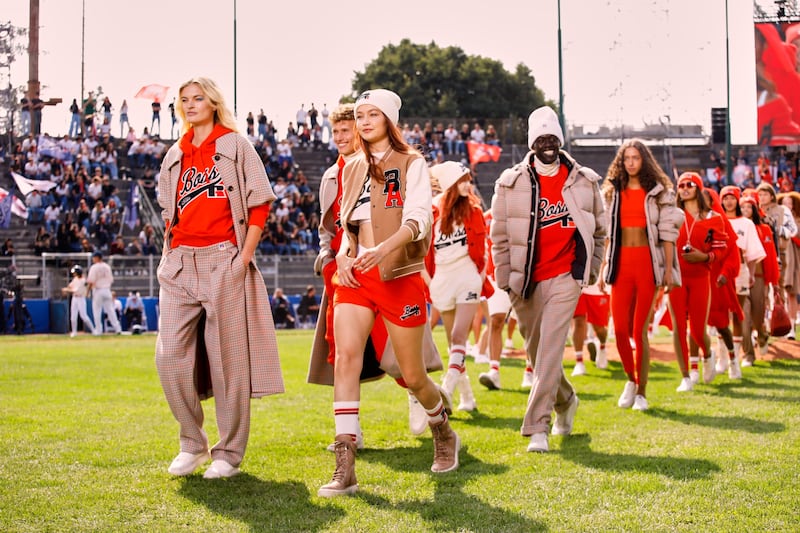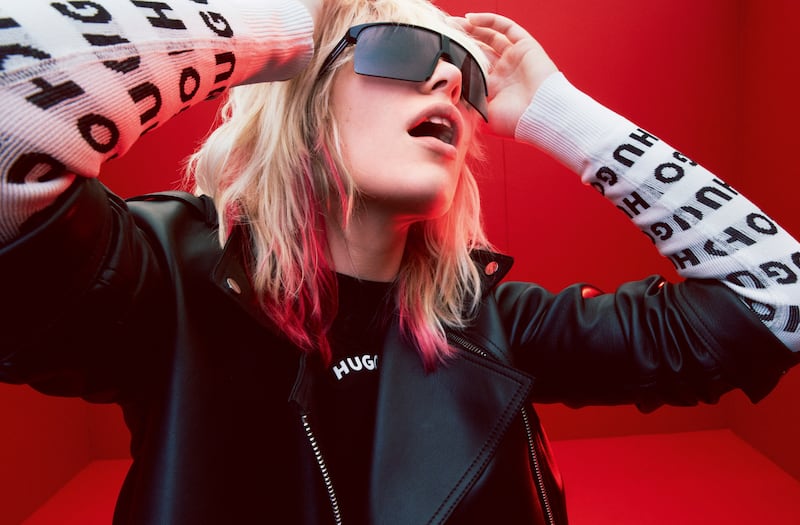
The Business of Fashion
Agenda-setting intelligence, analysis and advice for the global fashion community.

Agenda-setting intelligence, analysis and advice for the global fashion community.

Hugo Boss is set to launch a star-studded campaign Wednesday as part of the German tailoring giant’s latest bid to refresh its image for a post-pandemic world that has hastened the decline of suiting and other formal office wear.
The new Boss campaign features a global, ethnically-diverse cast, with menswear faces including American rapper Future, Korean actor Lee Min Ho, British boxer Anthony Joshua and Italian tennis star Matteo Berrettini.
The brand also enlisted top models Joan Smalls, Hailey Bieber and Kendall Jenner as it tries to boost awareness of its womenswear offer. Womenswear accounted for just 10 percent of sales in 2021.
The Spring/Summer 2022 collection shown in the campaign mixes sporty, streetwear-inflected looks with more elevated, but still relaxed pieces including the brand’s new line of stretch suiting separates. The clothes feature a blocky new logo, interlocking “B” print (think Burberry’s TB monogram) and a tight palette of black, white and camel — all of which the brand hopes to turn into recognisable signatures.
ADVERTISEMENT
While Hugo Boss has been working for years to gradually increase its casualwear offer, diversify its geographic reach (currently 63 percent of sales are made in Europe) and attract women consumers, the new campaign reflects a more radical step in terms of shifting its marketing away from an image that has remained mostly formal, mostly white and mostly male.
“Dress like a boss,” remains the message, said CEO Daniel Grieder, who joined the brand from Tommy Hilfiger last June. But what that means is changing. “Now everything is allowed as long as it’s modern and sophisticated,” he said.

Grieder is aiming to double Boss’s revenues to 4 billion euros ($4.5 billion) by 2025 by revamping the company’s branding, product development and digital operations.
Boss’ sales have rebounded sharply from 2020′s coronavirus crisis, and even resumed growth above pre-pandemic levels. Fourth-quarter sales in 2021 grew 12 percent over the same quarter in 2019. But the brand still has a long way to go to shift perception from a purveyor of premium suiting and other dressy office wear staples to one that can supply millennials with laid-back silhouettes adapted for a world transformed by the casualisation of fashion and the rise of work-from-home.
The new campaign also showcases newly differentiated branding for Hugo Boss’ main collection and diffusion line. The company now calls its core accessible luxury offer simply “Boss,” while labelling its junior offer “Hugo” (the latter was previously labelled “Hugo Hugo Boss” and referred to as “Red”).
Going forward, Boss will target millennials while Hugo will focus on Gen-Z, Grieder said. On the same day as the Boss refresh goes live, Hugo will push out its own campaign with over 60 TikTok creators commissioned to do a “Hugo dance.”
The campaign is the second major marketing push by the brand under Grieder, as well as its new senior vice president for global marketing and brand communications Miah Sullivan, who joined the company last May.
The first, a collab with Russell Athletic revealed during a Milan fashion show in September, enlisted TikTok stars like Khaby Lame to create viral content that helped introduce the brand to a new generation. The show garnered as much exposure on social media and in the press in one week as the company typically receives in two months, according to Launchmetrics.
ADVERTISEMENT

Media exposure for the Boss X Russell tie-up was more valuable than for a recent collaboration between two of the world’s biggest brands — Louis Vuitton and Nike — who released a special edition SD Dunk Low sneaker in December, Launchmetrics said.
A brand that’s best known for its suiting, Boss’ casual-wear offer has historically stood for neither good nor bad taste, but rather a kind of stylistic neutrality. The classic American varsity styles and joyful attitude of the Russell collab may have helped to shift perception of the brand’s casual-wear away from its formerly vague, European-airport vibe.
“It’s now clear to the young generation that this brand is not just a suiting brand,” Grieder said.
The new campaigns show that the more relaxed style seen in September is now working its way into the Boss’ main collection. And the move to include models who are also artists, athletes and television personalities could help the brand to make a bigger splash than relying solely on fashion models. (However, the campaign does not include major movie star Chris Hemsworth, the face of the brand’s perfume sold by licensee Coty).
The Hugo campaign includes stars, too, including dancer and television personality Maddie Ziegler and Guyanese-American rapper SAINt JHN.
Hugo’s new faces are models of individuality and self-expression. The common thread among the Boss cast is they are people who “lead a self-determined life,” Sullivan said.

The move to more clearly delineate between its two sub-brands — with both of them abandoning the “Hugo Boss” moniker, which will now be used for the company, but not its product lines — goes against the prevailing wisdom, seen at brands like Burberry, Armani, Dolce & Gabbana and Versace, who have worked to streamline their brand architectures and unify lines under a single brand in recent years. Those moves aimed to eliminate parallel cost structures, harness shared marketing heft and combat a less-exclusive positioning resulting from discounting in their secondary lines.
But Grieder says the more segmented approach will help tailor the message to different audiences. “The brand had to stop trying to be too many things to everybody,” Grieder said. In department stores, where Grieder anticipates a major comeback in upcoming quarters, he says the new branding will allow Hugo and Boss to occupy separate locations with more relevant adjacencies, without confusing customers.
ADVERTISEMENT
Wholesale revenues beat expectations by 15 million euros in the fourth quarter, a sign that “partners are on board with the brand turnaround strategy,” Jefferies analyst Kathryn Parker wrote in a note to clients. But accelerating sales at year-end had more to do with the rebound from coronavirus (98 percent of stores were open compared with widespread lockdowns last year), Parker said. The revamped logo and marketing are only just starting to be rolled out.
Editor’s Note: This story had been modified on 26 January at 12:50pm BST. Updates to clarify Miah Sullivan’s title. She is Hugo Boss’s senior vice president, global marketing and brand communications.
Tapestry and Capri have been trying to become the US’s answer to LVMH for the past eight years but Federal Trade Commission precedent indicates both companies could face battling the behemoth alone.
As the French luxury group attempts to get back on track, investors, former insiders and industry observers say the group needs a far more drastic overhaul than it has planned, reports Bloomberg.
After growing the brand’s annual sales to nearly €2.5 billion, the star designer has been locked in a thorny contract negotiation with owner LVMH that could lead to his exit, sources say. BoF breaks down what Slimane brought to Celine and what his departure could mean.
Balenciaga’s deputy CEO Laura du Rusquec will replace Andrea Baldo as the Danish brand aims to elevate its image.